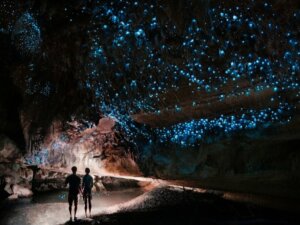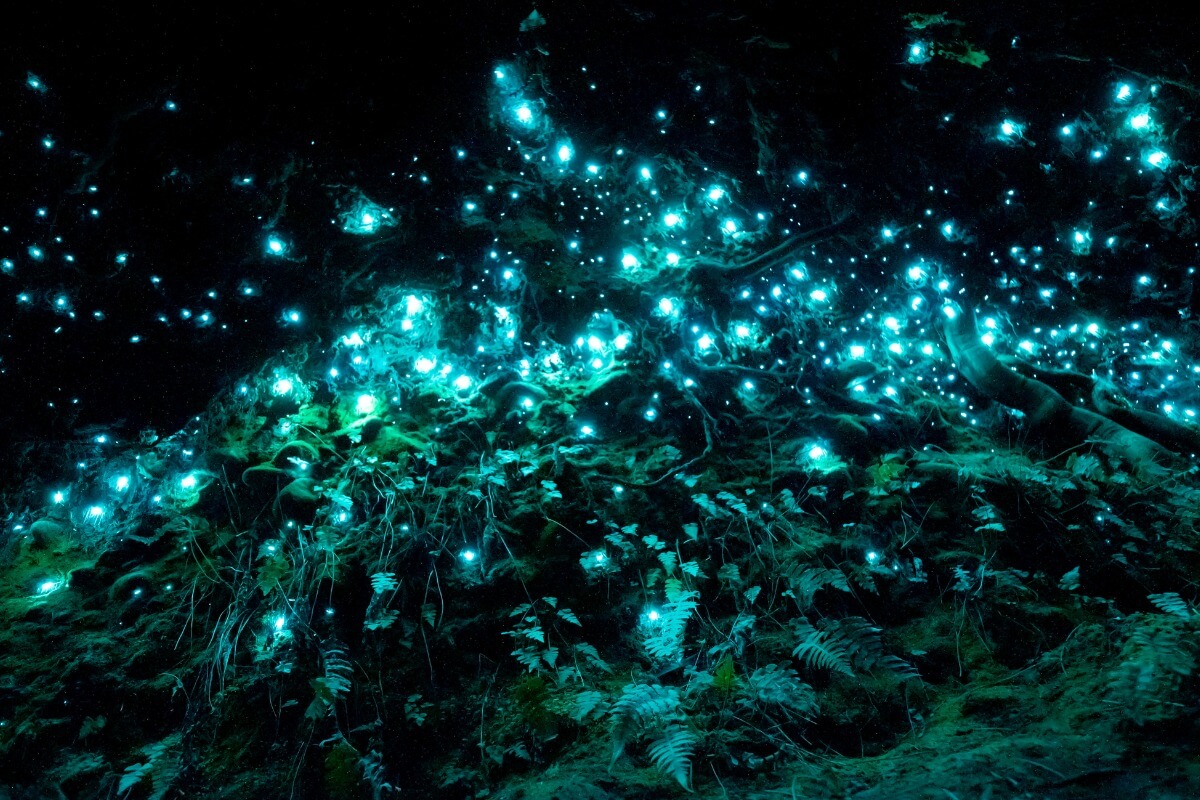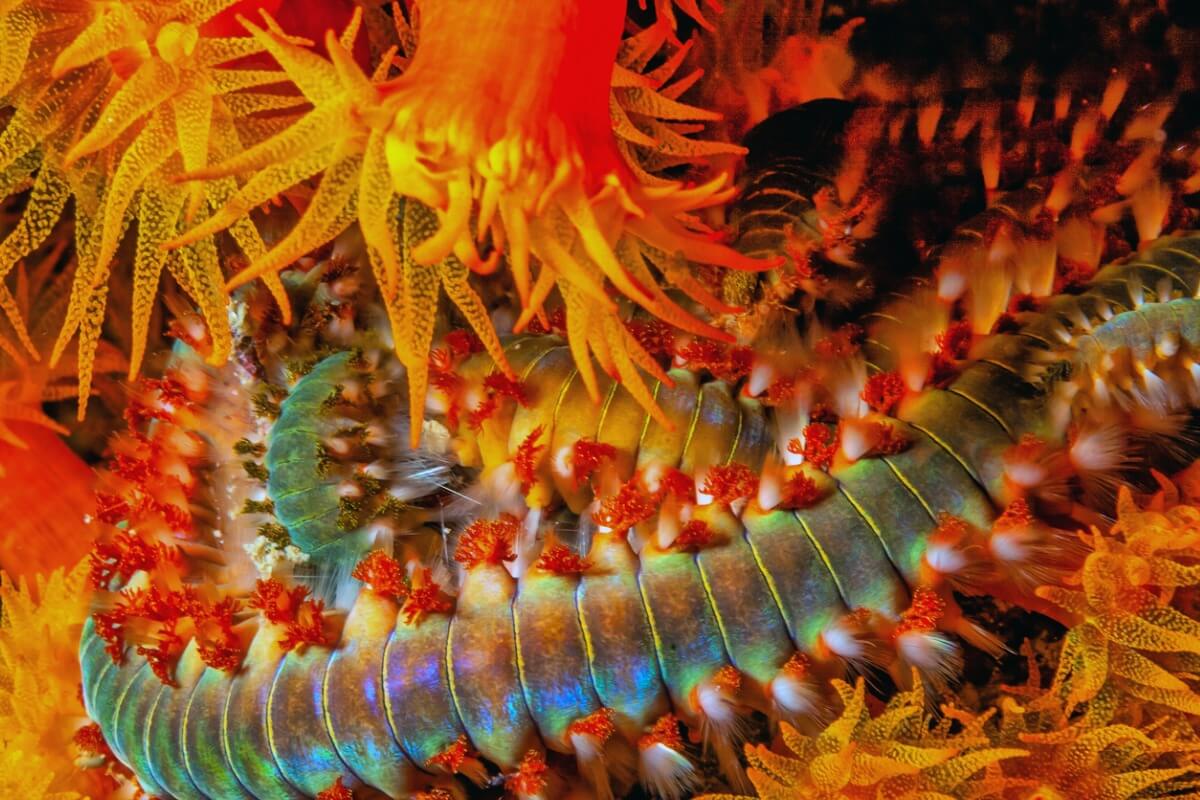Bioluminescence: Worms that Glow in the Dark


Written and verified by the biologist Francisco Morata Carramolino
Bioluminescence is a fascinating phenomenon by which living beings are able to produce their own light. This ability is widespread in various animal groups – from sharks to jellyfish to worms, many species glow in the dark. In this article, we’ll be looking at worms with this ability!
It should be noted that the term ‘worm’ is informal and lacks biological backing. Within it, we include annelids, nematodes, insect larvae and other organisms that aren’t related to each other, as long as they have a soft, elongated body and with limited or absent legs.
Since these animals can be similar to each other and share the ability to produce light, in this article we’ll address them as a whole, regardless of their evolutionary relationships. If you want to learn more about them, keep reading.
1. New Zealand light worm (Arachnocampa luminosa)
The first of the glow-in-the-dark worms is Arachnocampa luminosa. This organism is a larva of the fungus gnat, small dipterous insects native to New Zealand. In its larval phase, Arachnocampa luminosa is a fine and elongated worm, which can reach about 3 or 4 centimeters (between 1 and 2 inches).
During this time, the larvae roam the dark and damp caves where they live, looking for an appropriate place to build their nets. These are a series of rows hanging from the ceiling, filled with sticky, crystalline-looking droplets.
The larva is located in this structure and emits a bluish light through its abdomen. The light attracts the rest of the arthropods in the cave, and they try to approach it. However, the arthropods don’t see the worm’s sticky web and are trapped. After that, the worm only has to collect and devour them.
Although these invertebrates aren’t related to fireflies, the most famous luminous insects share the same mechanism of light production, through luciferin and luciferase. This means that the same chemical reactions have evolved several times independently.

2. Railroad worm (Phrixothrix hirtus)
Again, these worms are actually insect larvae. In this case, they are not diptera, but beetles (beetles) of the Phengodidae family. Rail worms are exceptional because they can produce two different types of light. On the one hand, they produce a red light through their heads, something quite unique among coleopterans.
On the other, they have two rows of luminous points, which run along their sides. In Phrixothrix hirtus they produce yellow light, while in Phrixothrix viviani they emit green colors. No other beetle in the world is capable of producing this variety of colors.
A recent study indicates that these glow-in-the-dark worms produce these very different colors thanks to modifications in their luciferases. These are enzymes that are an integral part of the light production system.
3. Bermuda light worm (Odontosyllis enopla)
These invertebrates have nothing to do with the previous ones. Instead, they are polychaetes, a group of annelids with a pair of appendages on each of their numerous body segments. Bermuda glowworms are noted for their beautiful and fascinating reproductive rituals, in which bioluminescence plays a crucial role.
Coordinating with the cycles of the moon, the Odontosyllis undergo physiological, anatomical and behavioral modifications. These animals transform their appendages for better swimming, hypertrophy their four eyes and modify their excretory organs (nephridia) to store gametes.
Between 3 and 5 days after the full moon, 55 minutes after sunset, the females leave their habitat on the seabed. These swim to the surface en masse, where they adopt a circular path and begin to release their gametes, along with a mucous substance that emits blue-green light.
Upon seeing it, the males vigorously swim towards them, while emitting brief flashes of intermittent light. When they reach them, they begin to release their own gametes, and external fertilization starts to occur. This process takes about 10-20 minutes and is very regular and predictable. After that, the polychaetes return to the seabed and go back to their normal lives.
4. Green bomber worms (Swima bombiviridis)
This last example is very interesting, as it shows a different use for bioluminescence. The polychaete Swima bombiviridis, as well as some of its congeners, has spherical structures near its head. These formations are similar to simple globes — filled with liquid — and appear to come from modified gills.
These structures aren’t used to hunt or reproduce, but as a defense. When faced with a threat, the worms are able to separate the spheres of their body, which are sometimes called ‘bombs’. When released, the bombs explode in a flash of intense light, which lasts a few seconds and then fades.
This allows the worms to escape predators with the help of their large paddle-like appendages. When the pumps run out, the worms can re-develop them very quickly.

Bioluminescence is a very striking phenomenon. It’s a fascinating area to look into, and we can discover molecules with some incredible potential uses in biomedicine. These little glow-in-the-dark worms could help to save lives, with a little help from modern science!
Bioluminescence is a fascinating phenomenon by which living beings are able to produce their own light. This ability is widespread in various animal groups – from sharks to jellyfish to worms, many species glow in the dark. In this article, we’ll be looking at worms with this ability!
It should be noted that the term ‘worm’ is informal and lacks biological backing. Within it, we include annelids, nematodes, insect larvae and other organisms that aren’t related to each other, as long as they have a soft, elongated body and with limited or absent legs.
Since these animals can be similar to each other and share the ability to produce light, in this article we’ll address them as a whole, regardless of their evolutionary relationships. If you want to learn more about them, keep reading.
1. New Zealand light worm (Arachnocampa luminosa)
The first of the glow-in-the-dark worms is Arachnocampa luminosa. This organism is a larva of the fungus gnat, small dipterous insects native to New Zealand. In its larval phase, Arachnocampa luminosa is a fine and elongated worm, which can reach about 3 or 4 centimeters (between 1 and 2 inches).
During this time, the larvae roam the dark and damp caves where they live, looking for an appropriate place to build their nets. These are a series of rows hanging from the ceiling, filled with sticky, crystalline-looking droplets.
The larva is located in this structure and emits a bluish light through its abdomen. The light attracts the rest of the arthropods in the cave, and they try to approach it. However, the arthropods don’t see the worm’s sticky web and are trapped. After that, the worm only has to collect and devour them.
Although these invertebrates aren’t related to fireflies, the most famous luminous insects share the same mechanism of light production, through luciferin and luciferase. This means that the same chemical reactions have evolved several times independently.

2. Railroad worm (Phrixothrix hirtus)
Again, these worms are actually insect larvae. In this case, they are not diptera, but beetles (beetles) of the Phengodidae family. Rail worms are exceptional because they can produce two different types of light. On the one hand, they produce a red light through their heads, something quite unique among coleopterans.
On the other, they have two rows of luminous points, which run along their sides. In Phrixothrix hirtus they produce yellow light, while in Phrixothrix viviani they emit green colors. No other beetle in the world is capable of producing this variety of colors.
A recent study indicates that these glow-in-the-dark worms produce these very different colors thanks to modifications in their luciferases. These are enzymes that are an integral part of the light production system.
3. Bermuda light worm (Odontosyllis enopla)
These invertebrates have nothing to do with the previous ones. Instead, they are polychaetes, a group of annelids with a pair of appendages on each of their numerous body segments. Bermuda glowworms are noted for their beautiful and fascinating reproductive rituals, in which bioluminescence plays a crucial role.
Coordinating with the cycles of the moon, the Odontosyllis undergo physiological, anatomical and behavioral modifications. These animals transform their appendages for better swimming, hypertrophy their four eyes and modify their excretory organs (nephridia) to store gametes.
Between 3 and 5 days after the full moon, 55 minutes after sunset, the females leave their habitat on the seabed. These swim to the surface en masse, where they adopt a circular path and begin to release their gametes, along with a mucous substance that emits blue-green light.
Upon seeing it, the males vigorously swim towards them, while emitting brief flashes of intermittent light. When they reach them, they begin to release their own gametes, and external fertilization starts to occur. This process takes about 10-20 minutes and is very regular and predictable. After that, the polychaetes return to the seabed and go back to their normal lives.
4. Green bomber worms (Swima bombiviridis)
This last example is very interesting, as it shows a different use for bioluminescence. The polychaete Swima bombiviridis, as well as some of its congeners, has spherical structures near its head. These formations are similar to simple globes — filled with liquid — and appear to come from modified gills.
These structures aren’t used to hunt or reproduce, but as a defense. When faced with a threat, the worms are able to separate the spheres of their body, which are sometimes called ‘bombs’. When released, the bombs explode in a flash of intense light, which lasts a few seconds and then fades.
This allows the worms to escape predators with the help of their large paddle-like appendages. When the pumps run out, the worms can re-develop them very quickly.

Bioluminescence is a very striking phenomenon. It’s a fascinating area to look into, and we can discover molecules with some incredible potential uses in biomedicine. These little glow-in-the-dark worms could help to save lives, with a little help from modern science!
All cited sources were thoroughly reviewed by our team to ensure their quality, reliability, currency, and validity. The bibliography of this article was considered reliable and of academic or scientific accuracy.
- http://www.bbc.com/earth/story/20160826-the-baby-gnats-that-light-up-a-new-zealand-cave
- Arnoldi, F. G., da Silva Neto, A. J., & Viviani, V. R. 2010. Molecular insights on the evolution of the lateral and head lantern luciferases and bioluminescence colors in Mastinocerini railroad-worms (Coleoptera: Phengodidae). Photochemical & Photobiological Sciences, 9: 87-92.
- Brugler, M. R., Aguado, M. T., Tessler, M., & Siddall, M. E. 2018. The transcriptome of the Bermuda fireworm Odontosyllis enopla (Annelida: Syllidae): a unique luciferase gene family and putative epitoky-related genes. PlOS ONE, 13: e0200944.
- Osborn, K. J., Haddock, S. H., Pleijel, F., Madin, L. P., & Rouse, G. W. 2009. Deep-sea, swimming worms with luminescent “bombs”. Science, 325: 964-964.
This text is provided for informational purposes only and does not replace consultation with a professional. If in doubt, consult your specialist.








